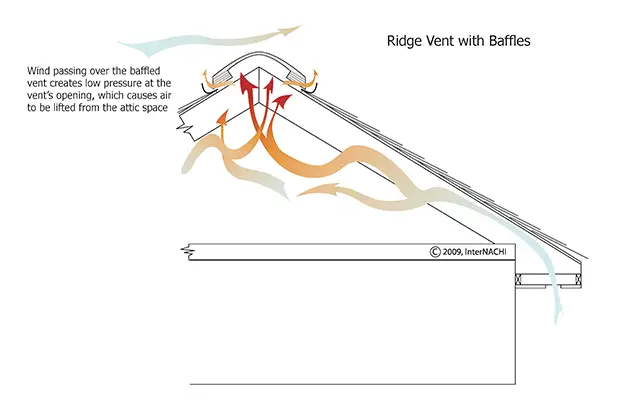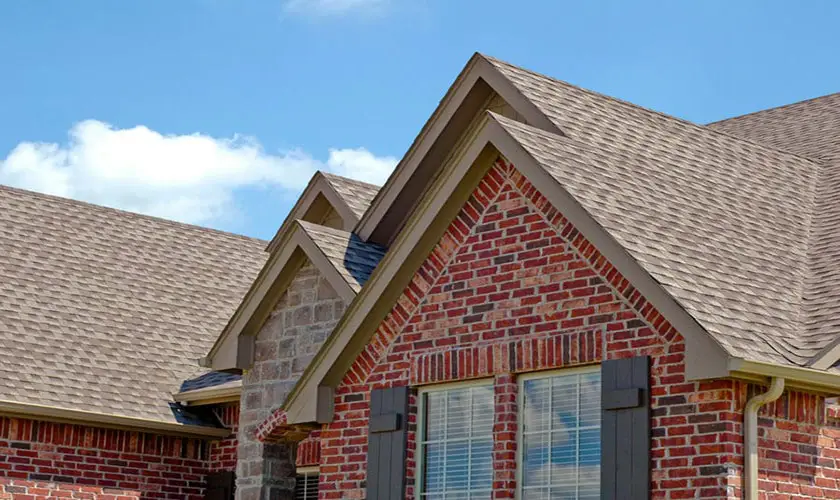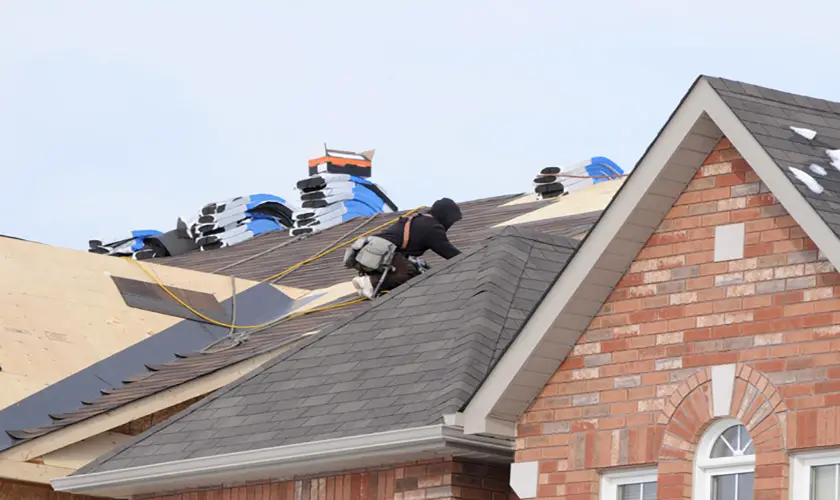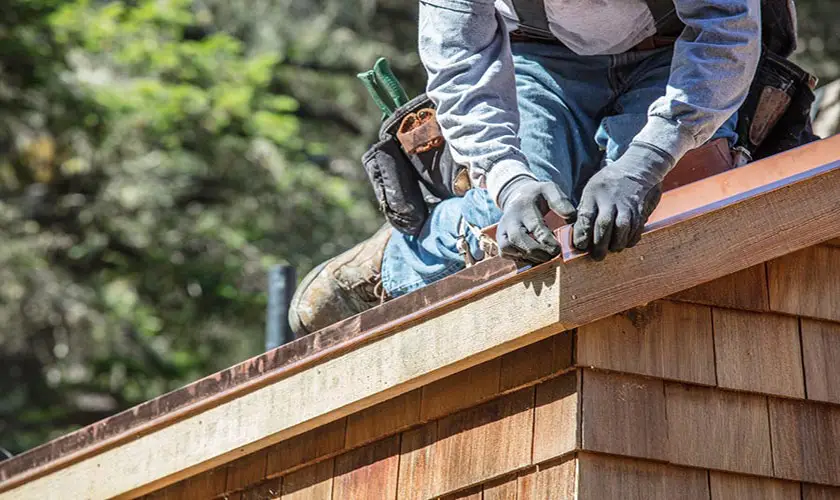
Installing ridge vents on your manufactured home can be a great way to help improve airflow and keep the home cooler. Here are some tips for installing ridge vents!
Ridge vents work best on a house with a 3:12 roof pitch or higher. However, not all manufactured houses have a 3:12 roof pitch or more. When considering using a ridge vent that might work on a manufactured home, you may find the ridge vent isn’t wide enough.
Most double-wide homes have at least a 3:12 roof pitch and would be suitable for a ridge vent, provided adequate soffit venting is present. A single-wide manufactured home will likely not be ideal for a ridge vent because of a lower roof pitch and limited soffit venting.
Can You Install a Ridge Vent on a Manufactured Home
Manufactured homes are designed to be efficient and cost-effective for homeowners who need a temporary or permanent residence.
Ridge venting also helps keep your house cool during hot weather by pulling heat up away from the structure thanks to soffit ventilation systems. This can reduce or even eliminate problems caused by temperature variations between inside and outside spaces – an issue common among many people living in manufactured housing!
Additionally, ridge vents can help improve insulation levels and energy efficiency – a great reason to install them if you live in an area where temperature variation is expected.
They’re also likely to decrease the number of problems caused by ice dams – another big concern for homeowners living in colder climates. Make sure that your roof has enough pitch before installing these types of vents as well- they will work best when there are at least 16 inches between rafters, so air flows easily through the attic space and out the ridge.
If not, it may be better to use traditional roof box vents instead (which don’t require as much slope). You should always consult with a professional about whether or not ridge venting would even sense, given your specific situation first.

Ridge Vents on Double-Wide Manufactured Homes
Many homeowners living in a double-wide manufactured homes are curious if ridge venting is an option for them. The answer, unfortunately, is not a simple yes or no.
While it is possible to install ridge vents on some models of double-width homes, the amount of ventilation space between rafters may be different than what’s needed – making the installation process more difficult. It’s always best to consult with a professional who knows your specific situation before attempting this home improvement project.
Even if you can install ridge venting on your home, it’s important to remember that you may need additional soffit vents as well for the system to work correctly.
It would be best if your manufactured home has a 12″ eave on the front and back for soffit venting. Many manufactured homes have 8″ to 12″ eaves on the front only. Without the rear eave and soffit venting, ridge vents will be useless.
Wall thickness is also a concern. Because the two halves of the manufactured home are connected, and the shared wall is a double 2 “x4″ layer totaling an 8” center wall thickness, you may not have sufficient clearance to allow for adequate airflow.
The widest ridge vent material is 10″. For the 8″ center wall thickness, you’ll need to give up 2″ on each side to cut a 1″ vent slot cut which doesn’t leave enough overlap to prevent the roof from leaking.
The ridge vent might function, but it is also highly vulnerable to wind and rain entry. Remember that the plywood deck is a structural component of the “house,” so cutting it back may be hazardous.

Ridge Vents on Single-Wide Manufactured Homes
Single-wide manufactured homes are generally considered not to be well suited for ridge vents.
Most single-wide manufactured homes have less than a 3:12 roof pitch and no roof overhangs. Even if the roof has a 3:12 pitch, the lack of soffit venting will render the ridge venting useless.
How Ridge Vents Work
A ridge vent is used on the top of a roof to help provide ventilation in your home, but it can be hard to install. Manufactured homes are generally pre-fabricated with factory-installed vents that may not work well with ridge venting systems.
If you live in an area where there’s little airflow or high humidity, then installing these vents will only compound the problem and make the air inside your manufactured home even less breathable than before. Installing them correctly is important so they don’t damage your roof or cause leaks.
Ridge vents work by using denser cooler air from the soffits. This cooler outside air pushes hot air out the attic through the ridge vent. The movement of the air is what helps to keep your home cool in the summer and prevents moisture build-up.
- Ridge vents are used on top of roofs to provide ventilation in homes
- Installing them incorrectly can damage roofs or cause leaks
- Ridge vents work by using denser cooler air from the soffits which pushes hot air out the attic through the ridge vent

What Roof Pitch for a Ridge Vent
Most ridge vents require a 3:12 roof pitch or better but check the manufacturer’s specifications to be sure.
If your manufactured home roof doesn’t have enough pitch, a ridge vent will likely not work as well as traditional roof box vents. This will help improve airflow through the attic without requiring as much of a slope on the roof.
Soffit ventilation is key when installing ridge vents – without it, the ridge vents won’t do much good!
Ridge Ventilation: Pros and Cons
There are several benefits to installing ridge vents on your manufactured home- they can help improve airflow, keep the home cooler, and even increase energy efficiency!
However, there are also a few benefits and downsides to consider before deciding.
Benefits of Ridge Vents on Manufactured Homes
One of the most significant benefits of installing ridge vents is that they can help improve airflow in your attic. Ridge vents are designed to work with soffit ventilation, allowing air to flow through both systems and out of the home.
This type of ventilation will also keep your manufactured home cooler during hot weather by helping draw heat up and away from the structure. This can reduce or even eliminate problems caused by temperature variations between inside and outside spaces- a common problem for many people living in manufactured homes!
Another benefit is increased energy efficiency. Ridge venting has been found to increase insulation efficiency, saving more money on heating bills!
Ridge vents may also decrease ice dams. When cold weather hits, ridge vents help keep air circulating through the soffit to prevent ice dams.
Downsides of Ridge Vents on Manufactured Homes
While ridge vents can help improve airflow and other issues, there are also some downsides to consider before making your decision.
One downside is that ridge vents might not work for everyone – if you have low roof pitch or your manufactured home doesn’t have much overhang, this type of vent system may not be the best option for you. You should always check with a professional before installation as well. They will assess the situation and tell you whether it’s right for your needs!
Additionally, ridge vents can be incompatible with some roofing materials, so it’s essential to check with a professional before installation if you’re not sure.
If your roof doesn’t have enough pitch, a ridge vent will likely not work as well as traditional roof box vents. This will help improve airflow through the attic without requiring as much of a slope on the roof. Soffit ventilation is key when installing ridge vents.
In Conclusion
Ridge vents can make a big difference in temperature variation between inside and outside spaces in manufactured homes (which is common among people living in these types of houses). They work with soffit venting to improve airflow, which helps keep the home cooler.
If you’re looking for even less variance, installing ridge vents may also decrease ice dams if there’s ever an issue around your area (saving money on heating bills) and increase insulation levels/energy efficiency – making them an excellent choice for warmer climates!
All in all, ridge vents are a great way to improve airflow in your manufactured home if the roof pitch is 3:12 or greater. You should ensure that you take all of the pros and cons into account before making a decision! Thanks for reading!







